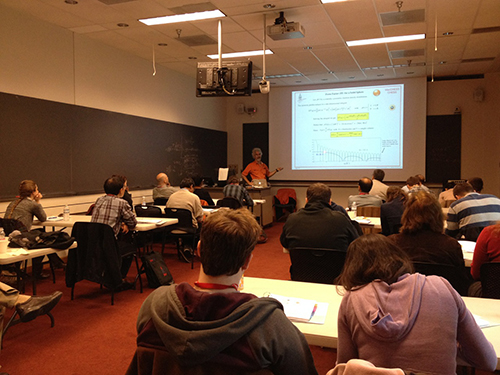X-RAY RUNS: Apply for Beamtime
2017 Nov 1 - Dec 21
2018 Feb 7 - Apr 3
2018 Proposal/BTR deadline: 12/1/17
2018 Apr 11 - Jun 4
2018 Proposal/BTR deadline: 2/1/18
The Macromolecular Diffraction Facility at the Cornell High Energy Synchrotron Source (MacCHESS) held its fifth annual BioSAXS Essentials workshop on October 30 to November 1, 2014. The workshop convened 6 speakers, all expert practitioners in various topics related to BioSAXS, who in a full first day of lectures, provided a solid foundation of the theory and application of solution X-ray scattering to an eager class with various industrial and academic appointments.
Richard Gillilan (MacCHESS) kicked off the morning session with scattering principles and captivating images during his BioSAXS introductory talk, saving a more in-depth lecture of scattering theory for a later session. Kushol Gupta (UPenn Med) followed with an overview of best practices for sample preparation and data collection, focusing on critical details often overlooked by newcomers. Part 2 of Richard’s BioSAXS introductory talk followed with an overview of BioSAXS data reduction and elucidation of the more basic structural parameters encoded in scattering profiles.

Richard Gillilan lecturing on day 1 of the BioSAXS Essentials V workshop.
The early afternoon session started with Thomas Grant (Hauptman-Woodward Institute) providing a basic but complete case for interpreting BioSAXS scattering profiles to model structural envelopes. Thomas keenly pointed out the possibilities but also limitations of this approach, and appropriate uses. Next, guest speaker Nozomi Ando (Princeton) gave her data processing tutorial using the ATSAS package while the class followed her step-by-step on their personal laptops. She covered a range of topics, not limited to data quality assessment, Guinier and Kratky analysis, Pair-distance distribution analysis and bead modeling through simulated annealing. The subsequent lecture by Alvin Acerbo (MacCHESS) covered the fundamentals and benefits of incorporating size exclusion chromatography, multi-angle and dynamic light scattering in a BioSAXS experiment, in an in-line configuration.
The final lectures of the day started with Steve Meisburger’s (Princeton) discussion of his pioneering work on time-resolved BioSAXS performed right here at CHESS. Steve also gave examples of how sucrose can be used as a nifty trick to turn off the scattering contribution from protein in protein-DNA complexes, effectively making only the DNA visible. Kushol gave his second lecture afterwards on atomistic modeling using scattering data from either x-ray or neutron based experiments with X-ray crystallographic information. He highlighted the computational tool SASSIE and its application to ensemble analysis. The final talk was by Richard, who concluded with clear pointers and guidelines for publishing scattering data.
The second day of the workshop began with a hands-on tutorial by Alvin Acerbo on processing of scattering data from inline HPLC-SAXS experiments using the US-SOMO software package and sample scattering data taken at G1. The tutorial covered several advanced topics, including data quality assessment and global fitting strategies. During the remainder of that and the subsequent day, workshop participants were given 6-hour slots on the BioSAXS stations at beamlines G1 and F1 to become familiar with basic BioSAXS data collection procedures. Besides performing BioSAXS experiments on protein standards supplied by the workshop, several participants brought their own sample for analysis.
Submitted by: Alvin Acerbo, MacCHESS, Cornell University
12/04/2014
